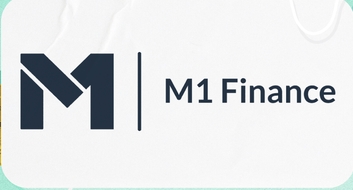Online investment applications are quite popular in today’s market. An investing app offers the user the ability to manage, optimize, and even automate their investments. In this article, we’ll be examining two of the most popular online investment services today – M1 Finance and Robinhood.
M1 Finance
 Billing itself as the “Finance Super App,” M1 Finance gives users an all-in-one investing platform from which they can invest, borrow, and spend their money. Each section of M1 Finance’s platform works together, providing users a comprehensive base for managing their finances all in one place.
Billing itself as the “Finance Super App,” M1 Finance gives users an all-in-one investing platform from which they can invest, borrow, and spend their money. Each section of M1 Finance’s platform works together, providing users a comprehensive base for managing their finances all in one place.
In this article, we’ll primarily focus on M1 Finance’s “Invest” platform. M1 Invest is a comprehensive investing service, offering self-directed investing with a tailored approach. You can think of M1 Invest as a sort of “mixture” between a robo advisor and a traditional brokerage.
With M1 Invest, you can choose from over 80 expert-built portfolios, or even build your own investment portfolio from scratch (with over 6,000 exchange-listed securities available). Basically, M1 Invest can be as hands on or hands off as you want.
Let’s break M1 Finance’s Invest platform down with a list of pros & cons:
Pros
- Simplicity – M1 Invest is designed for “self-directed” investors, but it offers quite a bit for both the active investor and the passive investor. The platform allows you to build a portfolio of the stocks and funds you want. Your investments are displayed on the user interface through each individual investment pie – basically a pie chart – which gives you an overview of how your money is invested. You can customize your own investment or choose from over 80 expert-designed pies, and you’re also free to combine both options.
- Automation Tools – M1 Finance doesn’t offer quite the level of automation that some robo advisors do, as it is geared to self-directed investors, but it does have an impressive range of tools for the passive investor. You can automate your contributions to your portfolio on a set schedule, which also includes dividend reinvestment plans (DRIPs). Also, M1 Invest can automatically rebalance your portfolio as you withdraw or deposit money from your investment account.
- No Fees – M1 Invest is a truly “no-fee” service. As opposed to some robo advisors that charge a roughly 0.25%-0.5% fee per year, M1 Invest is free to use. You can opt to join M1 Plus, which offers certain bonuses, but this is optional.
Cons
- Less Customization Than a Traditional Robo Advisor – Note that M1 Finance is not a traditional robo advisor. Traditional robo advisors will build your portfolio from scratch based on your risk tolerance. M1 Invest, on the other hand, offers various automation tools to put your portfolio on “auto-pilot,” with the option to choose from expert-designed portfolios (or “pies”). But, as opposed to robo advisors, you still need to select from these pies yourself.
- No Tax-loss Harvesting – Many robo advisors offer tax-loss harvesting, which automatically readjusts your portfolio so you pay the lowest tax possible (essentially by balancing capital losses against capital gains). Because M1 Invest takes a more self-directed approach, it unfortunately does not offer this to investors.
- Not for Traders – If you’re looking for a traditional trading platform, this is not it. M1 Invest is clearly geared toward long-term investing rather than short-term trading. It only offers one trade window per day, and its portfolio-geared approach is definitely aimed at investors who are more passive in nature (although not as passive as a robo advisory).
Robinhood
 Robinhood is one of the most popular investment apps on the market. As opposed to M1 Finance, the Robinhood investment app is geared toward a more traditional investor.
Robinhood is one of the most popular investment apps on the market. As opposed to M1 Finance, the Robinhood investment app is geared toward a more traditional investor.
It is designed to make investing quick, easy, and accessible, while offering enough tools to satisfy the more experienced investor.
Pros
- Commission-free – Robinhood offers a $0 minimum account balance and no-commission stock trading. Once you’re signed up, it’s an extremely affordable way to manage your portfolio, which is one of the main appeals of the entire platform.
- IPO Access – Robinhood partners with certain institutions or underwriters to give users access to certain IPOs. IPOs are often prohibitively expensive and not accessible via traditional investing means, but Robinhood has made partner-IPOs accessible to its users. This being said, it operates on a request basis, and a request does not guarantee a share.
- Trading Options – Robinhood keeps its investing options simple, as they only offer taxable cash and margin accounts. You can invest in stocks, an ETF, crypto, and options.
- Intuitive Platform – Robinhood’s platform is built around simplicity, and that’s reflected all across its user interface. It’s extremely easy to manage your portfolio, with interfaces that let you monitor your performance and make necessary changes as you see fit (sell, buy, etc.) You can even set up custom notifications to get all the latest news on your most-watched assets.
- Fractional Shares – Robinhood offers fractional shares to its users. In other words, you can buy a proportion of a share, as opposed to the entire thing. This is useful for the beginner investor, as many major companies trade their shares for thousands of dollars each.
Cons
- Lack of Advanced Research Features – A common complaint about Robinhood is that it lacks certain advanced research and analytics tools that are found in many other investment platforms. This was intentional, as Robinhood is trying to keep its interface as simple and accessible as it can. That being said, if you’re an advanced investor, it may not be the platform for you.
- Not Automated – We’ve talked a lot about automation in this article, specifically in regard to features offered by robo advisors . Robinhood is clearly not designed with automation in mind. If you’re looking for automated investing, look elsewhere, such as to M1 Finance or a dedicated robo advisor. The only automation feature of note on Robinhood is automated dividend reinvestment, which will automatically invest dividends into purchasing more of that share.
The Bottom Line – M1 Finance vs. Robinhood
M1 Finance – more specifically, M1 Invest – and Robinhood are two very capable investment platforms. They also both target very different customers and sit within very different niches in the investment space. Therefore, it’s not a question about which investing app is better, but which is right for you.
M1 Invest is geared toward self-directed investors who still prefer an element of passive investing. M1 Invest has a nice balance between self-directed investing (the ability to customize your own portfolio “pies”) and automated solutions (expert-created pies and various automation features). M1 Invest is a great choice if you’re a beginner or passive investor who wants to make responsible choices without extensive research and analysis.
Robinhood is geared toward active investors, but it’s also built its platform to be accessible for beginners. There are optional guides and newsletters to learn the ins and outs of investing, and the platform itself is streamlined and direct. It’s more appropriate if you want personal control over your portfolio, as well as the option to invest in stocks, ETFs, cryptos, and options of all sorts. Robinhood is one of the most popular investment platforms for a reason, but it might lack the advanced research tools that are preferred by advanced investors.
Or, if neither of these investment platforms appeal to you, perhaps you’d prefer a more automated approach. Certain investors prefer a completely hands-off, passive approach, opting to put their money with a robo advisor. A robo advisor is a comprehensive tool for building and managing your portfolio, all automatically. It’s a “set it and forget it” option. You can learn more about the best robo advisors here.
